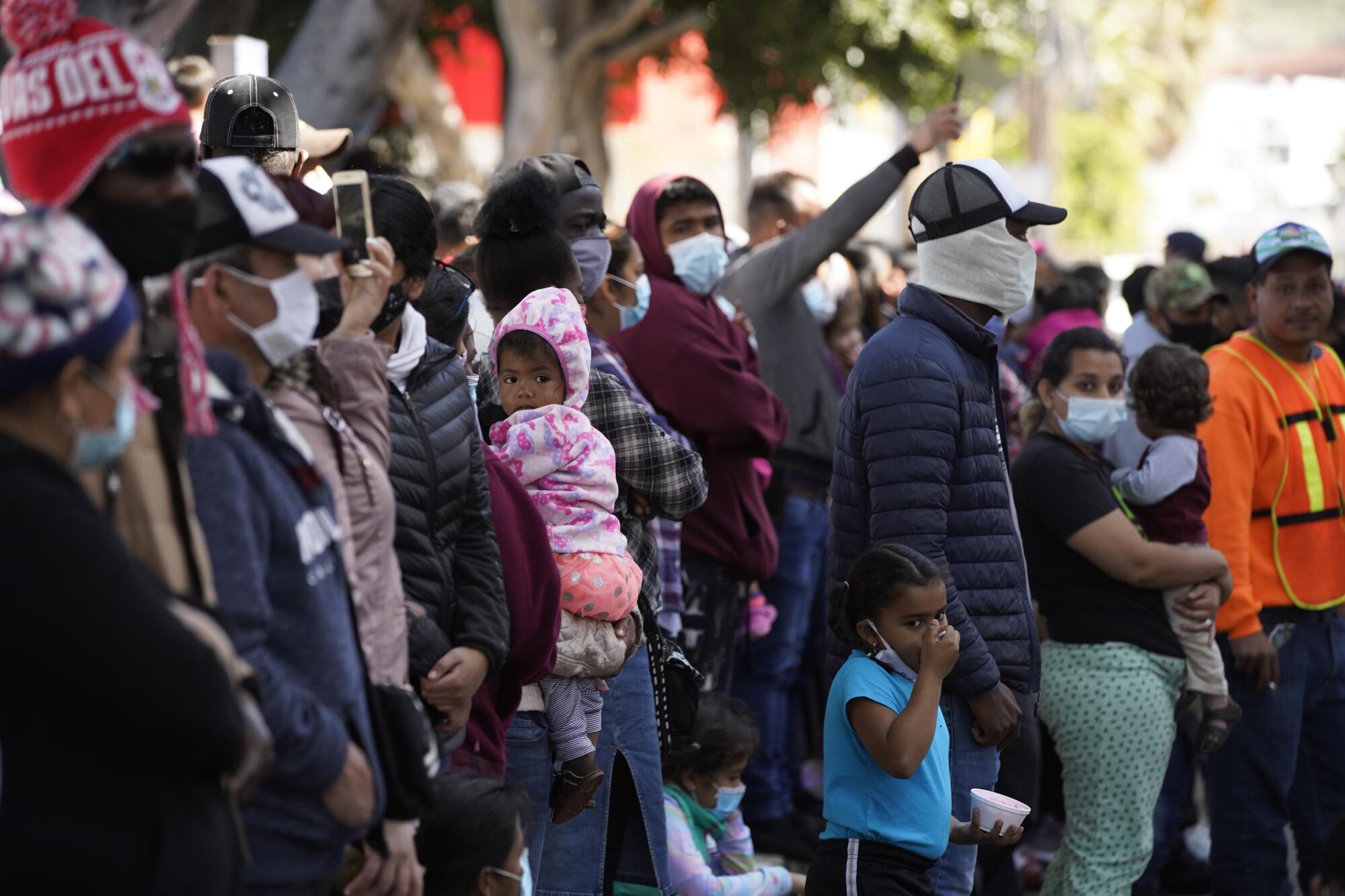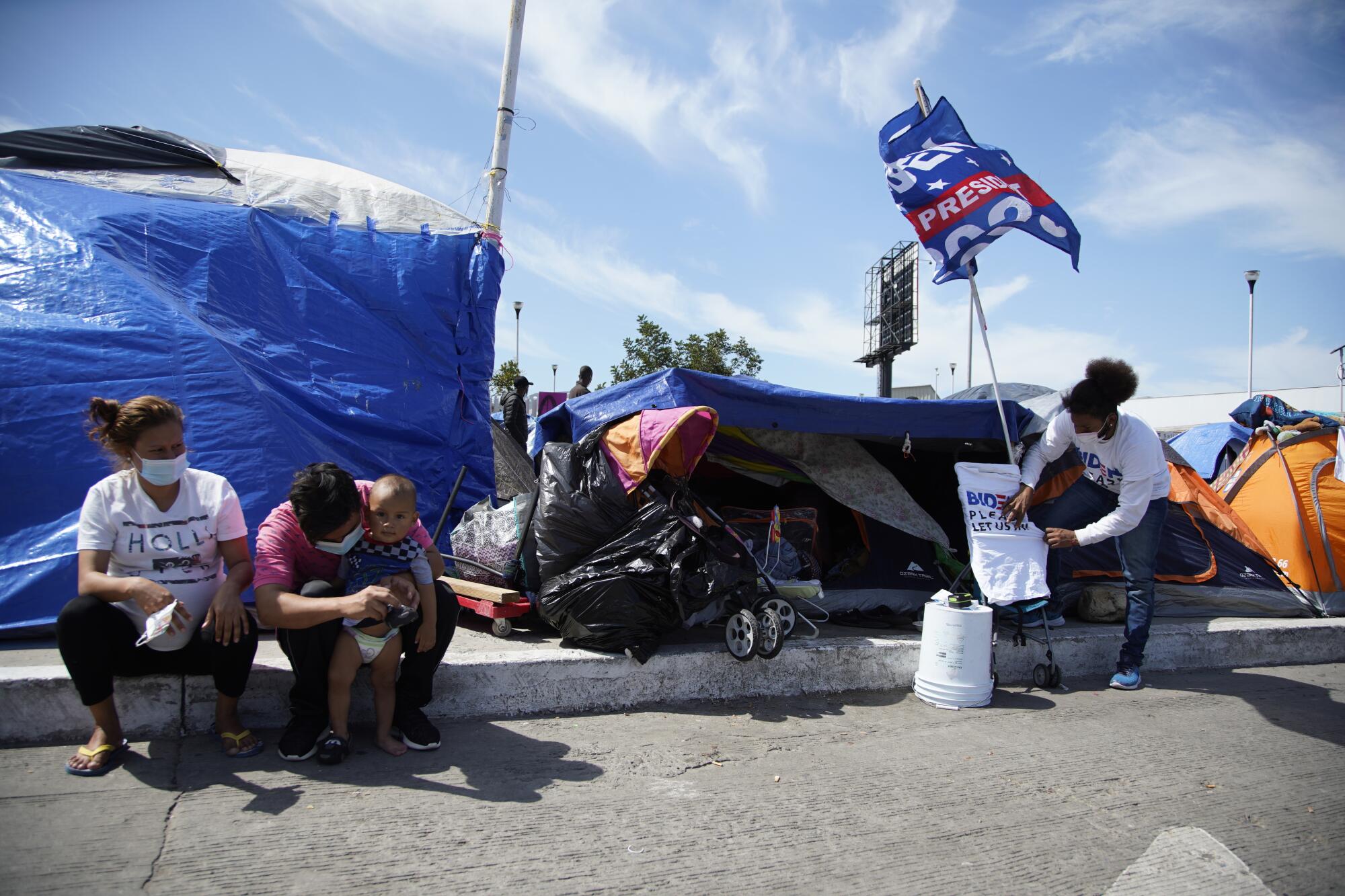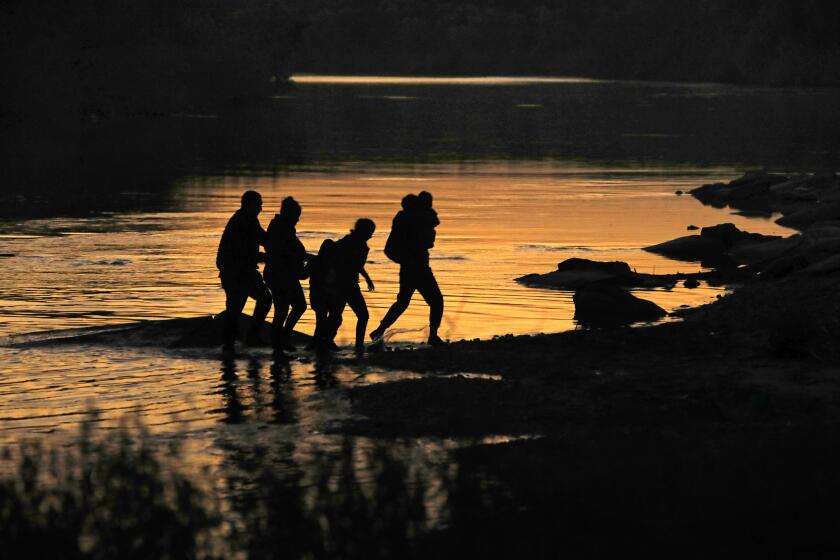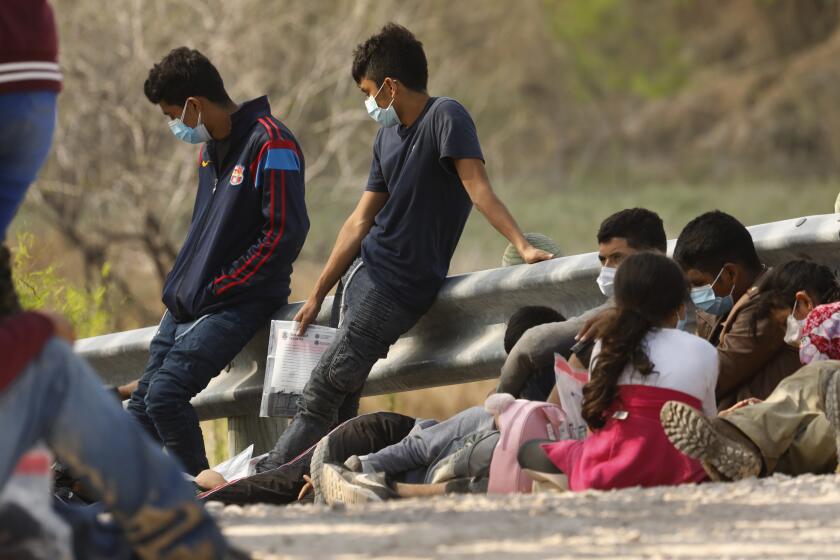
- Share via
SAN DIEGO — The Biden administration has urged people thinking of migrating north not to leave their homes.
But for many of the asylum seekers currently living in a growing cluster of tents right next to the San Diego-Tijuana border, the message to stay home is not helpful, nor are the administration’s promises of long-term migration solutions for the region. They left their homes long ago.
They have been stuck waiting for months and years in Mexico because of policies used by the Trump administration to try to deter people from requesting asylum. And while President Biden has taken some steps to change the former president’s asylum policies, there are many still in effect that prevent the roughly 1,500 people living in Chaparral plaza from even beginning their asylum requests, mere yards from the country that they hope will protect them.
“I have withstood everything that a migrant must,” said one Honduran in Spanish, her second language as an Indigenous woman. She listed a few examples: hunger, thirst and men.
U.S. officials recorded 100,441 encounters with migrants at the border last month — nearly triple the total in February 2020.
The woman, like other asylum seekers in the camp, asked not to be identified because of her vulnerable situation and fears of potential repercussions if the people she fled found out where she was.
She did not have paper proof of what had happened to her back home. Rather, she said, her body was her evidence. She shifted her clothing to reveal thick scars, including the places where a bullet meant to kill her had entered and exited her body.
She has already been in Mexico for more than a year, and there is no indication that she will be allowed into the United States in the near future.
Nearby, Customs and Border Protection officers at the port of entry ran through a publicized show-of-force drill intended to demonstrate their response to a large group of people rushing the border.
And across the border in San Diego, staff and volunteers with Jewish Family Service worked around the clock to provide care and make travel plans for the growing number of people in the organization’s migrant shelter, now operating out of rooms in four hotels because of the pandemic.
For asylum seekers trying to figure out how to request protection in the United States, the situation is one of growing confusion as they sift through rumors and inconsistencies.

“I don’t want to be here. We don’t want to be here,” said a Honduran man at the Chaparral camp. “I’m hoping for a fast response from the United States government.”
He has already spent a year and a half in Mexico with his wife, 8-year-old daughter and 6-year-old son. During that time, he’s been assaulted, and someone tried to kidnap and rape his daughter, he said. He reported the attacks, but police did nothing to help him.
“I don’t have help from anybody,” he said.
He lamented the disinformation spreading rapidly there.
“If the waitlist were active, this group of people wouldn’t exist,” he said, gesturing at the camp.
The waitlist he referred to was a byproduct of a Trump administration policy known as metering that limited the number of asylum seekers that ports of entry would process each day. Migrants and Mexican immigration officials together made a waitlist to keep track of who was next in line to enter.
U.S. officials recorded 100,441 encounters with migrants at the border last month — nearly triple the total in February 2020
When the pandemic began, ports of entry stopped taking asylum seekers altogether, and the waitlist shut down, too. Neither has resumed since.
Many at the camp incorrectly believed that when Biden ended the Trump administration’s “Remain in Mexico” policy and began processing asylum seekers from that program into the United States they, too, would be allowed in.
But for asylum seekers who do not have active immigration court cases through the Remain in Mexico program, the only way to request protection is to cross illegally and hope that they might be one of the few allowed to be released inside the country instead of returned.
That’s because Biden has kept in place another major Trump administration policy: a Centers for Disease Control and Prevention order known as Title 42, put in place during the pandemic, which says border officials can immediately expel people caught crossing the border without documents.
The Biden administration says migrants can still get protection under a Trump-era pandemic policy. But in a year, fewer than 1% have been able to do so.
Some get expelled back to Mexico, regardless of country of origin. Others are returned to home countries farther away.
In February, more than 70,000 of the nearly 97,000 apprehensions by Border Patrol — or about 72% — were then expelled under Title 42, some people multiple times.
Many immigrant rights advocates have argued the practice violates U.S. and international law. People who may qualify as refugees are not supposed to be “refouled,” or returned to a country that is likely to cause them further harm, without first being screened for refugee status through the U.S. asylum system.
So far, the Biden administration has officially ended Title 42 only for unaccompanied children. Tamaulipas, a state in Mexico that shares a border with the southernmost tip of Texas, has also begun refusing to accept some expulsions of families, meaning that some families caught crossing there have been released into the United States.
U.S. officials in that region in particular, known as the Rio Grande Valley Sector for Border Patrol, have seen the largest numbers of border apprehensions in recent months.
Historically, that part of Texas has also been a common crossing place for asylum seekers in recent years. Adding to that historic trend is the Biden administration’s inconsistent treatment of apprehended migrants as the administration juggles promises of a more humane approach with a system rooted in deterrence measures.
Border Patrol apprehensions in California have exceeded the number caught per month in a recent peak in 2019, but they are below the monthly peak from 2010, according to a Union-Tribune analysis of CBP data. Border-wide, apprehensions are below a 2019 monthly peak.
California has not seen nearly as much action as other areas.
About 14% of people that Border Patrol caught crossing the border in February were in California. That statistic is even lower for groups that are often used as an approximation for measuring asylum seekers’ movements.
Roughly 5% each of families and unaccompanied children apprehended by Border Patrol border wide last month were in California. Elsewhere along the border, the increases in crossings of unaccompanied children in particular have led to the Biden administration calling in the Federal Emergency Management Agency for help.
Some asylum seekers have given up on waiting in Tijuana and tried to cross in Texas because they heard families weren’t being expelled there — which is true in some, but not all, cases.
One father told the Union-Tribune his family is now staying with friends in San Diego after making the journey east and being apprehended by Border Patrol.
While some have managed to be released into the United States, others were expelled there as well.
And their likelihood for expulsion has increased now that apprehended migrants are being flown to San Diego every morning from the Rio Grande Valley to be expelled through the Otay Mesa Port of Entry to Tijuana.
The flights began Monday, and, according to the Consulate General of Mexico in San Diego, just under 400 migrants had been expelled to Tijuana from the flights through Friday morning.
San Diego Border Patrol agents are also processing border crossers from Yuma. Many of these migrants, particularly Cubans, have been released to the Jewish Family Service shelter, amplifying a need for more volunteers and more staff to safely manage the new arrivals.
“San Diego Sector is committed to assisting other sectors throughout the nation whenever called upon,” said Jeff Stephenson, an agent and spokesman for the sector. “Currently, we are assisting other sectors by processing undocumented migrants.”
He declined to say how many sectors San Diego agents are currently helping and deferred to the national office, which did not immediately respond to a request for comment.

The San Diego shelter supported 490 asylum seekers in February, including those from the Remain in Mexico program, according to Eitan Peled of Jewish Family Service, with Haitians, Hondurans and Russians representing the largest groups.
The March total had already risen to 1,510 partway through Friday, with Hondurans, Brazilians and Cubans as the largest groups.
But the decision to head toward the Texas border is risky — the potential for getting kidnapped or attacked by cartels along the way is high, and many migrants are injured or killed in the act of crossing the border itself. Add to that the uncertainty of being expelled or being released into the United States, and for many, it’s not worth it to try.
A group of Nicaraguans at the Tijuana tent camp said they knew that if they ended up expelled to their home country, they would be imprisoned and tortured by the Ortega regime. Their only choice, they said, was to keep waiting at the plaza in the hopes that things would change.
On Wednesday, they joined with representatives of other nationalities in the camp to send a message to Biden.
“We’re only asking for a clear, concrete response — what will happen to us?” a Honduran woman said.
She said Mexico had been indifferent to their struggle as migrants, and many others at the organized press conference chimed in with stories of being turned away from migrant shelters or being charged to stay in them. A man from Haiti said that in addition to those struggles, people in his community had to deal with racism.
“Please send us an organization or U.S. authority to represent us,” the Honduran woman said. “Migrants don’t have dignity. They kill our dignity.”
More to Read
Sign up for Essential California
The most important California stories and recommendations in your inbox every morning.
You may occasionally receive promotional content from the Los Angeles Times.













